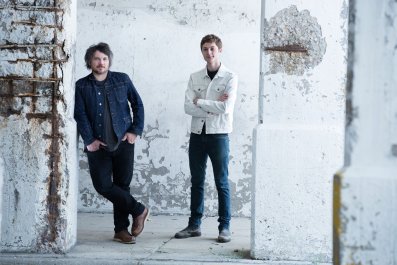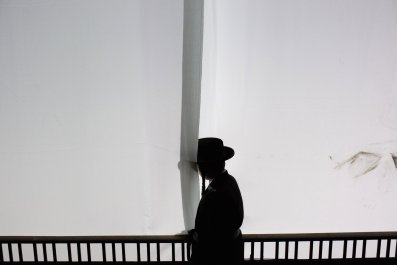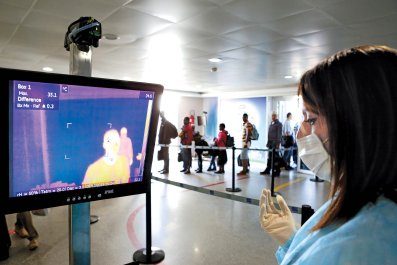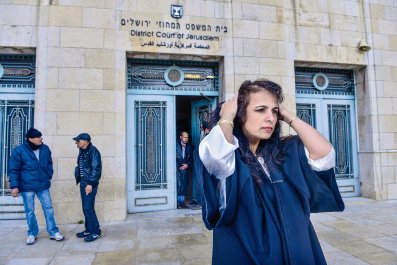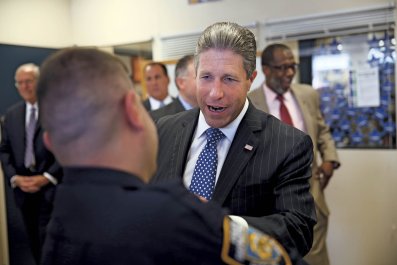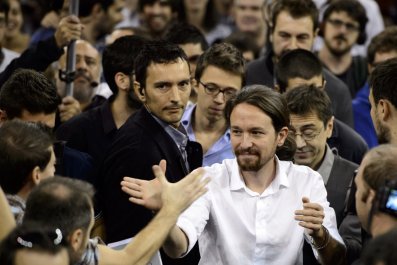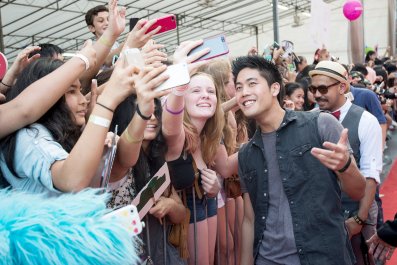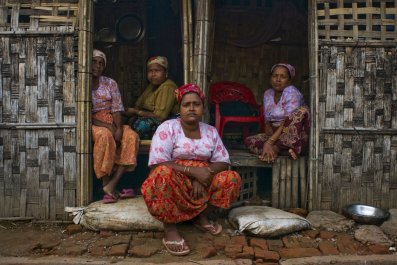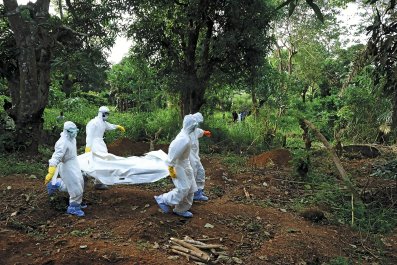I arrive at Bucknell University around 5 p.m. A line already snakes around the Weis Center for the Performing Arts, and for a moment I think Katy Perry must be in town. College students sit on the ground, their heads lowered into textbooks. Young parents and baby boomers chat in small groups, some reclining in beach chairs and snacking on picnic dinners as their children and grandchildren play on their smartphones, zoning out.
Lewisburg, Pennsylvania, where Bucknell is located, is two to three hours from pretty much anywhere, with no major airports nearby, and yet by 6:45 p.m., when the doors open to enthusiastic yelps, more than 1,200 people will race into the building, jockeying for seats. Some have come from across town, but many traveled far greater distances. They have come to see Jane Goodall, the primatologist-turned-activist whose revolutionary discoveries about chimpanzees forever changed our understanding of our closest genetic relatives.
Starting in the 1960s, Goodall's work in Tanzania, at the Gombe Stream Chimpanzee Reserve (now the Gombe National Park), was the subject of renowned National Geographic articles and documentaries. The images of her as a young woman, willowy and blonde, perched in the brush with a pair of binoculars in hand, are almost as familiar as Marilyn Monroe's white dress moment on that subway grate. And the discoveries Goodall made—redefining our understanding of chimpanzees and, in doing so, upending long-held beliefs about humans and the rest of the animal kingdom—catapulted her to international fame. She is arguably the most famous female scientist in history, revered as much for her work as for inspiring generations of girls and women.
Amy Stankiewicz, 25, an anthropology and biology student at nearby Bloomsburg University, sits cross-legged at the front of the line. She's been waiting since 2:40 p.m. "My plan is to absorb her strength and then smash her legacy on the ground," Stankiewicz says of Goodall. A group of young people directly behind her turn in unison, mouths agape. Stankiewicz laughs nervously, then adds that she used to fund-raise for the Jane Goodall Institute (JGI). "I'm here to learn things, but also to absorb her strength. 'Cause she's gonna die someday, so somebody's got to take the mantle," Stankiewicz says. "That's a horrible way of putting it. That's so shitty. But people should know who she is."
Despite the many children in the crowd, not to mention the 150,000 young people across 138 countries involved in Goodall's youth-led activism program, Roots & Shoots, there are still others who have never heard of "Dr. Jane," as she is affectionately called. Goodall turned 80 this year. Her National Geographic heyday is long over, and young people, from millennials down to kids in diapers, have a glut of fresher, albeit less admirable, celebrities to crush on.
Goodall travels 300 days a year, drawing thousands to lectures about her life's work and her myriad causes: conservation, saving endangered species, opposing genetically modified foods and fighting illegal hunting trades. Most of all, she wants to inspire younger generations to care—about the planet, each other and their future—and then to act. Fans track her lecture schedule as if they're waiting for Mother Teresa or Nelson Mandela to return to life and to a stage near them, and they show up at events lugging backpacks filled with books for her to autograph.
Whenever she speaks to crowds, Goodall is enchanting, hypnotic in her storytelling; when she says that every single person sitting out there can make a difference every day—that they can "take a place we've destroyed, give it time, perhaps some help, and once more it will become beautiful"—she is not only convincing but makes the work seem doable. It may sound like Hallmark prose from the worst-offending card, but attend any of Goodall's lectures and you'll be reaching for the pitcher of Kool-Aid.
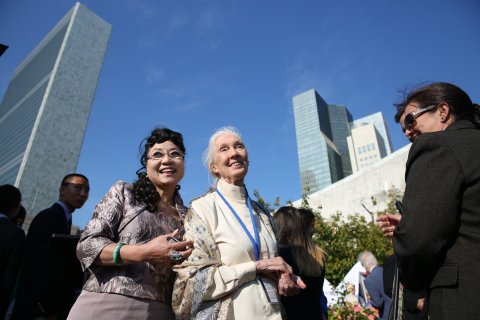
"I've seen her give quite a few talks and sometimes sat next to her when she signs books," says Anne Pusey, a professor and chair of evolutionary anthropology at Duke University and director of the Jane Goodall Institute Research Center there. "People start crying when they get nearby. By the time they're in front of her, they're shaking—it's amazing. It really is a rock-star thing."
A blonde girl wearing a tan quilted jacket starts jumping up and down, chanting, "Let us in! Please! Please!" Her name is Juliet Forrest, she's 6 years old, and she wants to be a veterinarian. Inside, event organizers mill around. Juliet presses her nose against the glass door as if Santa Claus is about to appear. "Pleeeeeeeease!" she begs.
"When my son was little, we would watch Jane on National Geographic and PBS. We'd follow David Greybeard and Flint and Flo and the whole story," says Juliet's grandmother, Diane Forrest, referring to three of the chimpanzees Goodall named at Gombe. "I started reading the children's books to Juliet.… We have been looking online for where Jane is for months." The Forrests drove that morning from Pittsburgh, four hours away.
Suddenly, Juliet grabs onto the door handle and lifts her body into the air, kicking her legs as if she's a chimp hanging from a branch. "Jane Goodall is the most awesome girl in the world!" she yells.
Stunning Lookers
Around the time Goodall was making her groundbreaking discoveries in Gombe, Gloria Steinem was becoming the face of American feminism. She pushed boundaries as a young journalist in 1960s New York, where she covered contraception and abortion. In 1972, she co-founded Ms. magazine, spearheading coverage of feminist issues. Her journalism career gave way to activism, and she became a leader in the women's liberation movement. Beauty played a key role in the careers of both women. Steinem was glamorous and modelesque (so much so that she went undercover as a Bunny at a Playboy Club), and she made it easier for women to become feminists without being accused of being shrill man-haters. Goodall's stunning looks helped launch her as a National Geographic cover girl. "I once asked Jane whether she thought her life would have been the same if she hadn't been young, blonde and beautiful, and she said absolutely not," Pusey recalls.
Earlier this year, Steinem and Goodall both turned 80. Steinem celebrated by riding elephants in Botswana. Goodall did what she does most days of every year: lecturing, raising funds for JGI and talking with fans. Fifty years after Goodall and Steinem started chipping away at that glass ceiling, their influence remains palpable, especially in a world where we still heatedly debate women's rights. But when we discuss the trailblazing women of the 1960s and 1970s—the Steinems, the Betty Friedans, the Bella Abzugs—Goodall is rarely mentioned. MAKERS.com, the largest digital library of women's stories, features interviews with luminaries such as Steinem, Hillary Clinton, Ruth Bader Ginsburg and Madeleine Albright. The site profiles more than 250 women. Goodall is not one of them. Perhaps that's because she never set out to launch a movement. Goodall has always been someone who inspires by doing, rather than shouting about what she's doing.
"I hated being labeled and branded a feminist in that time," Goodall says. "I grew up in another era, and in my family, I think the great thing was, never ever did any of them say there was something I couldn't do because I was a girl. If I'd grown up in a different situation, continually deprived of doing things because of my sex, then I might well have been a Gloria Steinem. "
'I Can Be Silly'
"I had requested a larger room," Goodall jokes as we walk into an auditorium with yawning ceilings, bright yellow walls and seats for hundreds. We are at the International Day of Peace at the United Nations in New York City, where Goodall has spent the day as a Messenger of Peace, one of 12 leaders who volunteer their time and celebrity to draw attention to the U.N.'s efforts around the world.
Goodall is short and slight, with her gray hair pulled back into her signature low ponytail and a tan and blue shawl draped over her off-white mock collared shirt. When she speaks, a Mona Lisa smile occasionally surfaces. We sit at a table in the corner, and as harsh white lights beam down on us, she looks at me and squints. "Do you mind if I put these on?" she asks, unfolding a pair of sunglasses. "It won't bother you, will it? You won't see my eyes so well, but I'll be looking at you."
It's impossible to interview Goodall without feeling as if you are the subject, the one being studied. She is, after all, one of the most heralded observers in the world, yet she is almost unsettlingly kind. "Some people are surprised to find that I have a great sense of humor," she says. "I can be silly, you know. I'm a totally ordinary human."
Goodall grew up in a middle-class family in England with an absentee father and a devoted mother. She has often said there was never a time when she didn't dream of going to Africa, and the anecdotes from her life have been told so many times they've grown into a cultural mythology. There is Jubilee, the toy stuffed chimp Jane's father gave her for her first birthday. (The animal, now bald from so much love, spends most of his time at her home in England.) There are her favorite books from childhood, The Story of Dr. Dolittle and Tarzan of the Apes (her go-to joke in lectures: Tarzan married the wrong Jane).
And there was her dog Rusty, who she says taught her that animals have personalities and emotions. When Jane was 1½, she brought a handful of worms with her to bed. Her mother didn't get mad; she simply returned the creatures to the garden. At 5, Jane once hid for hours in a henhouse. While she crouched inside, studying the chickens, her family frantically searched for her and eventually called the police. Goodall reappeared five hours later, rumpled and covered in straw but beaming. Rather than scold her daughter, Goodall's mother listened patiently as Jane recounted her discovery of how hens made eggs.
"Looking back, it is the making of a little scientist: curiosity and questions, not getting the right answer, trying to find out for yourself, making a mistake, not giving up, trying another way and learning patience," Goodall says. "With a mother who seized that child and said, 'How dare you go off?' all that excitement would have been crushed, and I might not be where I am today."
Goodall's family could not afford to send her to college, so she attended secretarial school. In May 1956, a friend invited Goodall to visit her family's farm in Kenya. Goodall worked as a waitress to save up for the round-trip fare to Mombasa, and it took her three weeks to get there by boat, followed by a train to Nairobi. "I really do simply adore Kenya," she wrote in a letter to her family after her first week there. "It is so wild, uncultivated, primitive, mad, exciting, unpredictable.... I am living in the Africa I have always longed for, always felt stirring in my blood."
In Nairobi, Goodall met Louis Leakey, the paleo-anthropologist whose groundbreaking discoveries proved that the origins of human evolution were in Africa. Goodall went to the meeting hoping to discuss animals. She left with a job as Leakey's secretary, and he had much bigger plans for her. He'd been searching for someone to study wild chimpanzees and look for clues into the ancestral past of humans and great apes. "I was the least likely candidate for the job," Goodall reflected in the documentary Wild Chimpanzees. "Looking back, it seems almost silly that I was chosen."
To Leakey, she was the obvious choice. He believed a woman's patience and unassuming demeanor would be ideal for studying chimpanzees in the wild. Even the fact that Goodall had not attended college was an advantage, he thought: It meant she would be free to observe on her own terms. Who needs scientific methodology and strict numbering systems when you can give chimpanzees names like Passion, Satan, Nope and Mustard?
Leakey's intentions weren't all pure here; he had a thing for beautiful young women. Goodall, along with Dian Fossey and Biruté Galdikas, rose to prominence as Leakey's "Trimates," the chosen darlings he sent out into the wild to study primates. Say what you will about his lecherous ways, but Leakey knew talent. All three women became giants in their fields: Fossey, who researched gorillas in Rwanda, was violently killed at her camp in 1985; her murder remains unsolved. Galdikas studied orangutans in Borneo, Indonesia, and remains an internationally recognized authority.
During those early days, Leakey wrote Goodall love letters, gave her roses and attempted to arrange overnights. "He was in his 50s, overweight, white hair, bad teeth. It was the furthest thing from Jane's mind," says Virginia Morell, who wrote the Leakey family biography Ancestral Passions. Goodall ignored the advances. "He held the key to my future, but I was always slightly nervous that I might lose the opportunity because, well, he was a womanizer," Goodall says, laughing. "Leave it at that. But I didn't lose the opportunity."
'This Can't Be Real'
Gombe is long and skinny, 20 square miles on the shores of Lake Tanganyika. Rising up from the slender, rocky beach are mountains covered in forest. Hills are studded with valleys and gorges, which give way to a tangle of thick vines and, farther up, wooded grassland and treeless peaks. Over a dozen streams cascade down the terrain. At night, especially after it rains, a rich, earthy smell infuses the air as nocturnal birds called nightjars sing out: dah, dah, daaahhhhhhh, and bush babies call to each other. In the distance, you can hear the crack of palm nuts falling from trees and smacking onto the ground. Just before dawn, more birds start chirping. Crickets buzz. Baboons bark and monkeys rustle in their nests high up in the trees.

On July 14, 1960, Goodall first stepped into this otherworldly, seemingly impenetrable morass, armed with little more than a tent, a few cooking supplies, a pair of cheap binoculars and that innate ability to observe. She was 26 years old. With help from Leakey, she secured funding for a preliminary study of Gombe's chimpanzee population.
Africa was still called the dark continent, as mysterious as it was presumed dangerous. Allowing a young woman to roam its forests alone was inconceivable, and so the British government, which controlled Tanzania (then Tanganyika), required Goodall to bring a companion. Her mother accompanied her, as did an African cook. "It was the dry season. We were on the boat, going along the shore of Lake Tanganyika with the hills going up, with thick forest in the valleys," Goodall tells me. "I was thinking, 'How on earth—how, in all this space, one little me—am I going to find the chimpanzees?"
On that first day, after this unlikely trio set up camp and organized their meager belongings, Goodall skirted off into the brush. She climbed up a nearby hill. "I remember hearing baboons and birds calling. It was getting towards evening.... [I was] just sitting there and thinking, This must be a dream. This can't be real. That night, after we'd had our little supper, I pulled my little bed out under the palm tree and just lay there and thought, I don't believe this is happening."
Each morning Goodall set out by herself in search of chimpanzees. In the beginning, she struggled to get close to the animals. "They took one look at this 'white ape' who came into their territory, and vanished," she says. Each night, she'd return to camp frustrated, worrying about the money running out and afraid of disappointing Leakey. But she persisted, and gradually the animals stopped running away. One day, a chimp with gray whiskers, whom she named David Greybeard, ventured into her camp. "He was the very first chimpanzee who let me come close, who lost his fear," Goodall said later. After David, the other chimps followed.
In late October, Goodall witnessed David Greybeard carrying something curious—"something which looked pink," she wrote in a field journal. At first she thought it might be a newborn chimp, or perhaps a chunk of honey. Then she got a better look and realized he was eating meat, even though it was scientific dogma that chimpanzees were vegetarians. A week later, she saw David Greybeard strip leaves from a twig, poke it into the ground and probe for termites. That observation helped prove that humans were not the only toolmakers. When Leakey learned of Goodall's observation, he made his famous declaration, "Now we must redefine tool, redefine man, or accept chimpanzees as humans."
Thrilled by Goodall's research, Leakey helped organize funding from National Geographic and insisted that she earn a doctorate in ethology, the study of animal behavior. Goodall arrived at Cambridge University in 1962, but colleagues looked down on her for not having a college degree and criticized her research techniques, especially her decision to give chimps names instead of numbers, and to discuss their personalities and emotional lives. Anthropomorphizing animals was, at the time, a sin no serious scientist would even consider committing.
"I didn't really want to be a scientist. I was only at Cambridge to please Louis Leakey," says Goodall. "But what enabled me to get through all that was, at some level, I didn't care. Because I knew I was right."
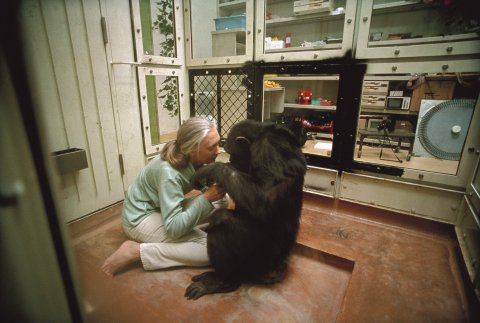
Goodall went on to discover that chimpanzees have distinct personalities and form emotional relationships. She studied their aggression, documented a four-year war among Gombe chimps and pioneered insights into the critical bonds between mothers and infants. With each discovery, the evolutionary chasm between humans and animals narrowed.
When Goodall talks about her favorite moments with chimpanzees, she often refers to the first time Flo let her infant chimp, Flint, reach out and touch Goodall, or when David Greybeard took a banana from her hand, or the time Wounda flung her arms around Goodall in a long embrace just moments before being released into a sanctuary. The names and stories of the Gombe chimpanzees read like deeply nuanced profiles of characters in a screenplay, complete with details about their friendships, affairs and bouts with illness. (In 1966, six chimpanzees died or disappeared during a polio epidemic, and another six were crippled.)
Goodall continued researching at Gombe almost without incident, until May 19, 1974, when four research assistants were kidnapped at gunpoint by guerrilla soldiers working for rebel leader Laurent Kabila. They were beaten, held in mud huts and ordered to write ransom letters demanding nearly $500,000 from the Tanzanian government. Government officials denied the demands, but weeks later, the students' families raised enough money to pay the ransom.
The raid was "the day the world changed, as far as Gombe was concerned," Anthony Collins, director of baboon research at JGI's Gombe Stream Research Center, told National Geographic. The way researchers collected data forever changed. The W.T. Grant Foundation, once a major donor, pulled its funding. Two years later, Goodall established her institute.
In 1986, she attended a conference in Chicago that forever changed the course of her career. Her landmark book The Chimpanzees of Gombe had just been published, and Goodall was already planning the second volume. But during a session on conservation, she realized just how rapidly chimpanzee habitats were being destroyed. Forests were disappearing. The illegal bushmeat trade was rampant, and chimpanzee populations were decreasing. A secretly filmed video revealed chimps living in small cages at a medical research lab.
"When I arrived in Chicago I was a research scientist," she reflected in Dale Peterson's biography Jane Goodall: The Woman Who Redefined Man. "When I left I was already, in my heart, committed to conservation and education. Somehow I knew that Volume 2 would probably never be written—certainly not while I was still active and filled with energy."
Today, JGI raises awareness about great apes, conservation and research. Roots & Shoots, which started with 12 Tanzanian teenagers in 1991, has grown into a powerful grassroots initiative that encourages young people to identify problems in their communities and create solutions. Goodall has written 25 books and received 47 honorary degrees. In 2002, she was appointed a United Nations Messenger of Peace. Two years later, she became Dame Jane.
Today, Goodall often paints a grim picture of our planet, from pollution and shrinking water supplies to poverty and human population growth. But she advocates in a way that's accessible and motivating, not polarizing. "She is utterly devoid of self-promotion," says Dr. Francis Collins, director of the National Institutes of Health (NIH). "Her only agenda is the protection and nurture of living things, and that's enormously appealing to anyone who's willing to listen." Goodall was instrumental in Collins's decision to retire 310 of the NIH's 360 medical research chimpanzees. "She made the case that the NIH needed to look at this issue and decide whether the kinds of experiments we were doing [on chimps] were justified in the modern era."
'Can I Touch You?'
On paper, Hugo van Lawick was the perfect match. A wildlife photographer and filmmaker, he'd been sent to Gombe by National Geographic to document Goodall's work. They fell in love, married in 1964 and had a son three years later. "I wish that my marriage with Hugo had worked," she says, calling its failure one of her great regrets. "It seemed so ideal, him loving animals, with his camera, and me loving animals. But there were things that were much deeper than that which didn't work." They divorced in 1974.
A year later, she married Derek Bryceson, head of the Tanzanian National Park. He died of cancer in 1980, leaving Goodall devastated. She never considered remarrying. "I married two jealous men, one after another, and that was quite enough, thank you. The way I'm living my life now, I couldn't marry…. No husband would really want to share me the way he would have to. You know, my private life, unless I'm at home in England, it doesn't exist anymore."
What Goodall has shared, decade after decade, is her time and experience as new generations of primatologists bloom. "She's the top of the pyramid," says Craig Stanford, a professor of biological sciences and anthropology at the University of Southern California, where he is also co-director of the USC Jane Goodall Research Center. He explains that, starting in the late 1960s, Goodall invited two young British researchers, Anne Pusey and Richard Wrangham, to work with her in Gombe. An American, William McGrew, followed soon after. They and many others are now at the top of their academic fields and training younger scholars (Pusey at Duke University, Wrangham at Harvard, McGrew at the University of Cambridge).
"I'm slightly bewildered," Goodall says of the endless adulation she receives from colleagues, students and strangers across the globe. "The number of women who have said to me, 'It was because of you that I'm doing what I do… '" she says, trailing off. "And then the children who've said, 'You've taught me that because you did it, I can do it too.'"
Goodall remembers the first time she realized the power and reach of her message. She was walking through a street market in Fort Worth, Texas, when an elderly couple approached. "The woman said, 'Can I touch you?' I thought, This is creepy!"
Another time, she met a couple in a hotel elevator. Later, they slipped a note under her door, asking if she'd be willing to write a letter to their son, who was struggling with anorexia and bulimia. She said yes. Months later, Goodall met the boy. "He was nearly in tears the whole time," she says. "He said, 'You don't know it, but I think you saved my life. I'm still not completely OK, but I'm having counseling, and you're the one thing that's given me hope and makes it possible for me to go on.'"
All that from one chance meeting in an elevator. Goodall has hundreds, perhaps thousands of these stories. And though she's grown accustomed to her fame, it was never something she sought out. "It's the politically correct thing to say, but I don't feel humbled. I feel slightly amazed. Like, how did this happen? I didn't seek it out. I've just been me."
'I'm Jane, I'm Here'
When she walks onto the stage at Bucknell, Goodall doesn't even wait for the roar of applause to fade before she leans into the microphone and says, "I'm going to start off with a greeting." Immediately, she lets loose a piercing, high-pitched jungle cry: "Hoo hoo hoo hoo hoo hoo hoooooo-hoo hoooooo-hoo hooooo." Then: "It simply means, 'I'm Jane, I'm here.'"
The audience erupts again.
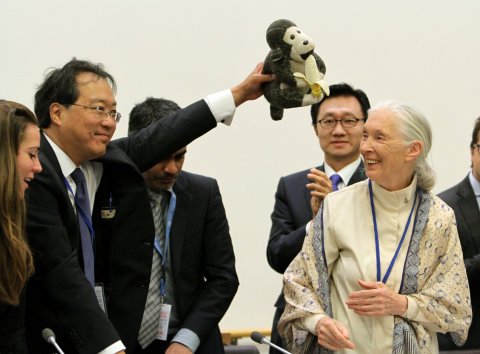
Sitting in the third row is an insect-loving 10-year-old who wants to be a scientist when she grows up. "Jane Goodall is my hero," Ellie Stoner tells me. "I love animals and I like chimpanzees a lot, and I've always wanted to go to Africa."
"She used to carry spiders around in little containers," her mother, Tina Stoner, adds. "She cried when she was younger if Grandma killed a spider. No insects die in our house." Tina, a teacher, drove Ellie nearly seven hours, all the way from Lancaster, Ohio, to be here tonight. "What an experience for my 10-year-old daughter to have," she says. "We're both skipping school."
It sounds awfully familiar: a devoted mother doing everything she can to support her daughter's passion for science and the natural world. A young girl who loves insects, wants to work with animals and can't wait to visit Africa.
As Goodall approaches the one-hour point in her lecture, she turns to the young people in the audience. "It's one of my greatest reasons for hope: Young people, when they know the problems, are empowered to act, will change the world and are changing the world," she says. "Every single day we live, we make an impact on the planet. And when billions of people are making the right, ethical, ecological, social choices each day, then we get the kind of world that we won't be so ashamed to leave to our grandchildren."
For nearly three hours before Goodall's lecture began, I'd been posing the same question to every child I interviewed: "If you could ask Jane Goodall anything, what would it be?" I heard the same answer, time after time: Everyone wanted to know why, out of all the animals on Earth, she chose to study chimpanzees. Everyone except Ellie. Her question, as Goodall would put it, has all the makings of a little scientist: "If you go to Africa again, can I come with you?"





